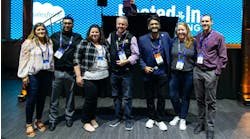Early this year, ComEd installed at Chicago’s Beethoven Elementary School a series of 30-foot-tall Remote Power Units (RPUs), miniature power plants that draw energy from a wind turbine, solar panels and battery storage.
The off-grid lights are pilot projects in ComEd’s Community of the Future initiative, focused on using smart-grid technology to become more connected, green and resilient, while developing interests and skills among students in STEM (Science, Technology, Engineering and Math).
“We hope this innovative lighting solution will not only light up the physical paths students walk on, but show them that STEM isn’t just something you study in a classroom; it can transform everything from the internet to your walk to school,” said Shay Bahramirad, vice president, engineering and smart grid, ComEd.
The RPU has a unique wind turbine that enhances airflow into the blades, causing a generator to efficiently produce energy and power the LED lighting. It combines the potential for wind at any hour of the day with daytime solar and a battery storage unit large enough to power the light for up to five days with no generation. The RPU powers its own internet connectivity to monitor and control its operation.
We posed questions to Dr. Mellodie Brown, principal of Beethoven Elementary School. Take a look…
Smart Industry: Is educating Beethoven students about data-analysis/smart solutions a priority?
Dr. Brown: At Beethoven Elementary School we are working to expose our students to the use of a wind/solar off-grid power unit, which is installed on our school’s campus. Through the use of this technology, our students will have the opportunity to learn from the research of the Remote Power Units that will allow us to create awareness of wind/solar energy and how this technology generates renewable energy from sources that are naturally replenishing. Having our students engage in the data-analysis of energy-renewable sources is a priority for us. Our students will have the opportunity to read and record the data from the Remote Power Unites to help them gain a more in-depth understanding of energy and how weather relates.
Smart Industry: What lessons will science teachers create based on data coming from this lighting network?
Dr. Brown: One of the positive benefits of this partnership and having the Remote Power Units on our campus is the fact that our designated teachers will be trained on the model and its features to optimally benefit our students’ learning experience. The lessons for this real-world experience of teaching and learning science will be aligned to our current curriculum, which provides lessons on wind/solar labs, projects, and an understanding of energy and how weather relates. Our students will apply the learning from their data-analysis to observe and discuss energy conservation, which leads to programmable dimming of the unit; energy efficiency, which is directly related to LED lighting; renewable energy, which is powered by wind and solar; and energy storage, where students will be able to observe data and how energy is stored without wind or solar for a period of time.
Lastly, our students will dive deep into the data/IT, which will show a correlation with the self-powered internet. This learning experience allows our students to learn real-world science beyond the four walls of our classrooms and build upon our students’ 21st century learning skills in the following areas—collaboration and leadership, critical thinking and problem solving, creativity and innovation, social responsibility and cultural, global and environmental awareness.


